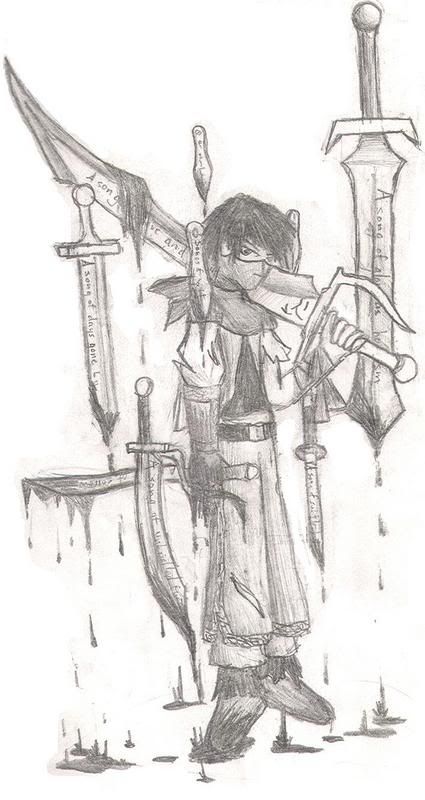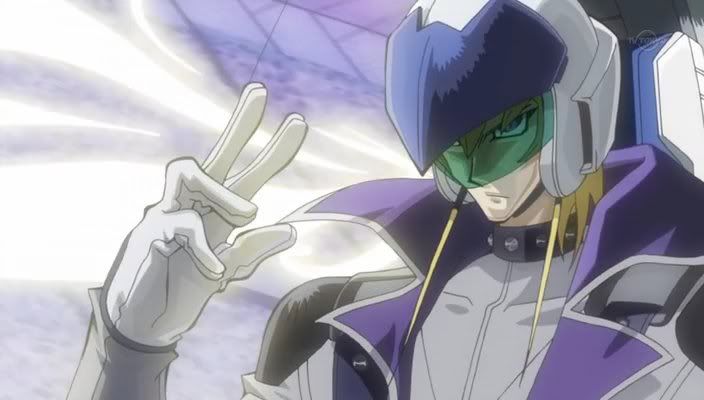First off, I take no credit for the system or the ideas derived thereof. For those who wish to get more detailed information, the book of reference is Manga Matrix by Hiroyoshi Tsukamoto.
Part 1- What is the Matrix?
For all of you who are expecting something involving Keanu Reeves, leave... Just leave. For all others, the answer is simple. A matrix is simply a grid built of rows and columns. Each row and column has an attribute tied to it and the cross section of each row and column is called a cell, which incorporates the attributes of both its row and column.
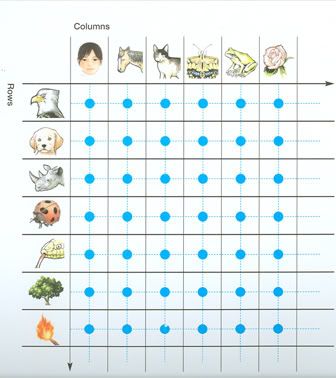
Part 2- Base Composition of the Character
Ok... Time to relate this to RERN. Essentially the method is to start by selecting a base form(s) from the form table.
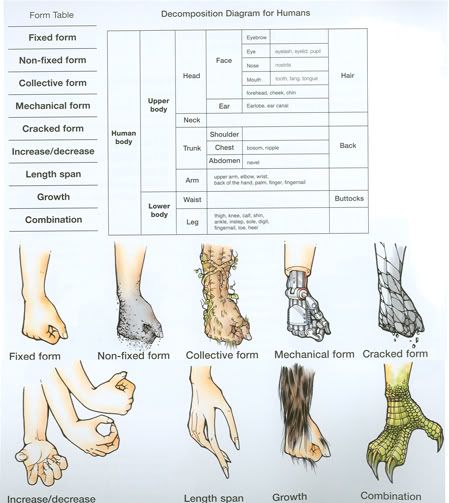
This is what will be the essence/structure of your character physically. Each of the forms are as follows:
Fixed Form: Typical human/navi figure
Non-Fixed Form: Human/navi Shape comprised of shapeless material, such as sand or ice.
Collective Form: Human/navi figure attained through a collage of similar materials such as vines and roots.
Mechanical Form: Created through machine parts
Cracked Form: Broken and weathered structurally, but still resembling form.
Increase/Decrease: Multiplies or reduces the number of body parts.
Length span: Stretched or shortened body parts.
Growth: Grows extraneous elements from body parts; i.e. Fur, horns, wings.
Combination: Swaps/combines a body part for a body part of another creature.
Most basic and current navis have Fixed or or Mechanical forms, though quite a few have Growth (Wings) and Combination. Fewer still have some of the others (Teethman = Collective Form).
Part 3- General Shaping of the Character
Ok... Now that we know the rough composition of the character it needs a shape. While there is nothing wrong with having a human looking navi, for the more adventurous of us I suggest consulting the following table.
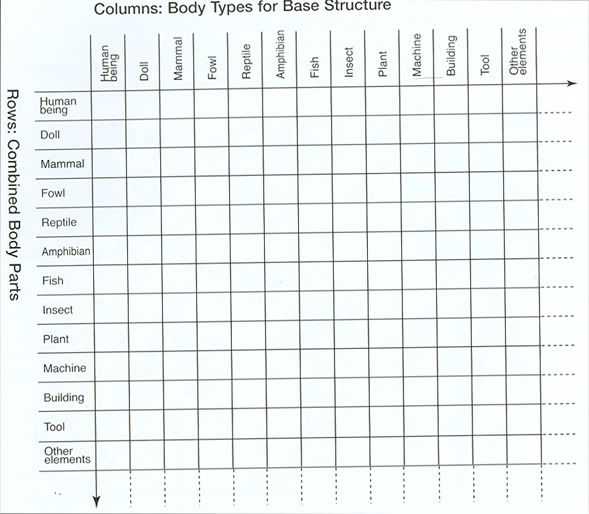
How this is supposed to work is as follows; Each column (vertical) represents the main shape of the character. Each row (horizontal) represents what the character's body parts are combined with of other animal, vegetable, mineral, or other. So a Human being (column) / Fish (row) may look like the Creature From the Black Lagoon, while a Fish(Column)/Human Being(row) may look like a mermaid.
Also, since a good number of the categories are vague... Here's a little table that provides some more specific examples of what falls into each category.
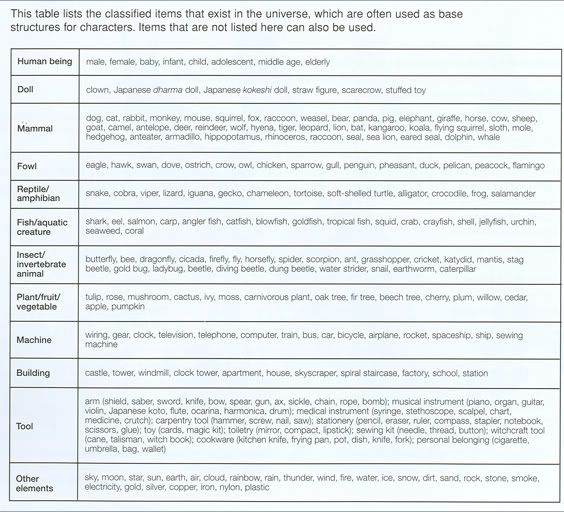
So even if you choose Insect(column)/Insect (Row), it doesn't mean that it has to be the same type of insect... You could have a combination Dung Beetle shape with characteristics of a Scorpion.
Part 4- Specific Shaping of the Character
While simply stating that a character is a complete cross between two appearances is perfectly acceptable, by slightly tweaking a composition to a localized body part it opens even greater numbers of customization and flexibilty in your character.
Confused? Take a look at the following table.
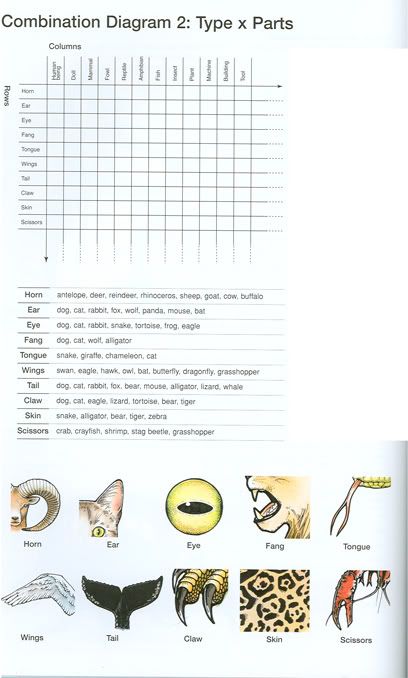
The columns are the same shape listing whilst the rows have been replaced with a deconstructed set of parts (in this case animal body parts) of the secondary subject from the previous matrix. So in the case of the Fish/Human Being (Mermaid), the rows would be filled with the deconstructed body parts from the diagram in Part 2. Checks would be in the Upper Body or all of the parts outlined beyond it.
This brings up another point I've failed to bring up thus far. You are in no way limited to a single choice under any of these matricies or tables, however it makes things a lot simpler if you try not to vary outside one column or one row at first. Otherwise you could just be creating one large homunculus that has little, if any, method of connection between the parts it is comprised of. Of course, if what you are looking for is some absurd amalgamation of parts, then by all means feel free to experiment.
Part 5- Redefining the Norm
When you think of an angel, typically you think of a humanoid with wings sprouting from their back. Well, that may not be the only case. After all, it is more the fact having the wings than the fact of them sprouting from the being's back. For a different approach, how about the wings sprout from it's hip? Perhaps it would replace the ears. Attached to its heels?
You get the picture. Simply because a body part is located in a certain place on one being, when combined onto another it doesn't mean that it needs to absolutely be in the same place. For suggestions on placement of the new parts derived from the previous section, refer to decomposition diagram (See graphic in Part 2).
Part 6- Clothes make the... thing
As tempting as it is to simply leave your newly created character completely in the buff, it's unlikely that it would be all too well accepted in any place save a nudist colony or certain peoples dreams (and/or nightmares). Some form of covering not only enhances the feeling of the character containing some form of identity, but also helps to determine it's likes and what sort of choices the character would make.
The types of garments/coverings are as follows:
Body Wear: Clothing that covers more than one major body part. Ex: suit, dress, uniform, leotard, etc.
Covering/Footwear: Clothing that covers just one major body part. Ex: Mask, glove, shoe, glasses, tights, etc.
Ornament: Accessory with main design for appearance over function. Ex: ring, necklace, brooch, barette, scar/wound
Makeup: Art directly applied to the body. Ex: lipstick, tattoo, eyeshadow, body carvings, etc.
Wrap/Tie: Clothing/fabric with function that tends to hang off the body. Ex: bandage, cast, turban, bandana, artifical leg, etc.
Carry-on item: Any held object not previously listed. Ex: weapons, shields, instruments, toys, tools, personal belongings, etc.
Obviously this list barely touches the tip of the iceberg, but hopefully it's enough to inspire. Again multiple pieces of clothing is perfectly fine, but too much tends to become a walking fabric store.
Additionally, each item should have a defined material, color, and shape. Here are some ideas as to possible essences/theme for each item.
Heaven: sky, moon, star, sun, cloud, rainbow, rain, wind, thunder, etc.
Earth: dirt, sand, rock, stone, tree, leaf, petal, shell, feather, hide, fur, leather, cloth, etc.
Water/Fire: drip, snow, ice, flame, smoke, etc.
Inorganic matter: gold, silver copper, iron, nylon, plastic, concrete, fiber, etc.
Image: light, darkness, etc.
Part 7 - The Character Behind the Character
Let's face it, characters can't all be about the looks. There has to be some substance (or lack thereof) behind the figure or else a character flops. Here we break down a character's personality into six sections.
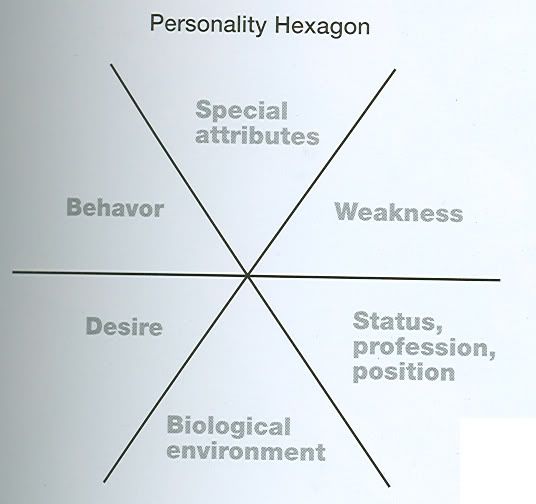
Behavior: The being's emotion, will, and character.
Examples: angry, cry baby, scared, gloomy, cheerful, optimistic, capricious, shy, arrogant, lonely, hasty, easy-going, timid, devilish, good-natured, ill-natured, serious, cold, delicate, nervous, selfish, arbitrary, impudent, egotistic, rough, ferocious, lecherous, honest, dishonest, cunning, brave, supple, pure, unrestrained, kind, strict, humanistic, hysterical, difficult, frivolous, narcissistic, sadistic, masochistic, romantic, flirtatious, etc.
Status/Profession/Position: The being's social position, work qualifications and learned profession.
Examples: Status - king, queen, prince, princess, knight, gentleman, lady, billionaire, patriarch, chairperson, army general, nobleman, slave, etc.
Profession - lumberjack, flutist, minstrel, actor/actress, street performer, magician, puppeteer, wizard/witch, fortune teller, dancer, singer, painter, inventor, teacher, student, scholar, doctor, nurse, lawyer, judge, driver, carpenter, bartender, waiter/waitress, shopkeeper, assassin, terrorist, soldier, ninja, samurai, police officer, hunter, detective, etc.
Position - justice advocate, evil mastermind, leader, follower, master, pupil, traveler, pet, president, employee, secretary, merchant, manager, caretaker, monster, etc.
Biological environment: The being's habitat, diet, and activities.
Examples: Habitat - mountain, forest, woods, hollow of a tree, nest, cave desert, soil, river, fountain, lake, canyon, ocean, icebreg, city, underground, spiritual world, heaven, hell, interior of:jar, lamp, gem, crystal ball, mirror, picture, inside doll, dish, precision machinery; fire, water, wind, soil, dream, mind, house, etc.
Activity - Nocturnal, diurnal, sleepless, wakes up once in a number of years, etc.
Food - herbivorous, carnivorous, omnivorous, cannibalistic, eats: anything, love, dreams, hopes, etc.
Special attributes: The being's personal special abilities
Examples: flying, diving, speed running, jumping, high-speed movement, Herculean power, virulence, mimicry, petricifation, reflection, absorbtion, transformation, possession, deformation, alter ego, fission, fusion, duplication, recovery, immortality, regeneration, resurrection, hot air, cold air, fire breathing or blowing, wind/fire/water/soil/human/monster manipulation, ability to talk with animals, vision in the dark, heightened senses, transparency, elasticity, intelligence, singing, dancing, performance, music playing, cooking, hallucination, curse, spell casting, beam, barrier, telepathy, telekinesis, clairvoyance, teleportation, second sight, etc.
Weakness: A being's weakness; a creature without a weakness is not interesting
Examples: morning, light, darkness, rain, thunder, smoke, wind, fire, water, sand, ice, dust, hot air, cold air, animal name, food name, man, woman, child, temptation, tears, money, cross, holy water, prayer, noise, etc.
Desire: A being's wants to obtain something; this may lead to conflict in a character.
Examples: love, courage, dream, joy, hope, freedom, pleasure, heart, trust, life value, meaning of life, youth, eternal life, power, wings, friend, lover, family, teammate, beauty, wisdom, intelligence, flesh and blood, food, drink, home, clothes, energy, money, status and honor, hometown, reminiscence, memory, etc.
Feel free to flesh out certain areas of the matrix in further detail. Others still may best work with a multitude of items describing it (Behavior is the big one). Personally, the strongest three areas for telling the personality of the character are Status, Profession, Personality- to further the appearance and to determine a first impression (though could be replaced by a descriptive Biological Environment); Behavior - basic decision making, rational and moral thoughts, as well as quirks all stem from here; and Desire - the subconscious, the will, the heart, the gut feelings... Call it what you like, it comes from this.
((A side note: A number of these examples are obviously prohibited from RE:RN due to power issues (in the case of special abilities) or other common courtisies. Please consult character creation rules section for what is and isn't allowed.))
Part 8 - Knowing the character you want to create
Now that you have all these methods of fleshing out the character, how do you put it all together? Normally you have some loose idea of a character or theme you want to work with. If not, the best place to start would be Part 2 or 3 to come up with a general form of the character. However, for those who do have a rough idea in mind, it may be best for you to jump ahead to Part 7 and flesh out the personality before jumping back to work on the form and clothing.
Here's an example of how the book does it by brainstorming a form then working up the character from the Desire trait of the Personality Matrix.
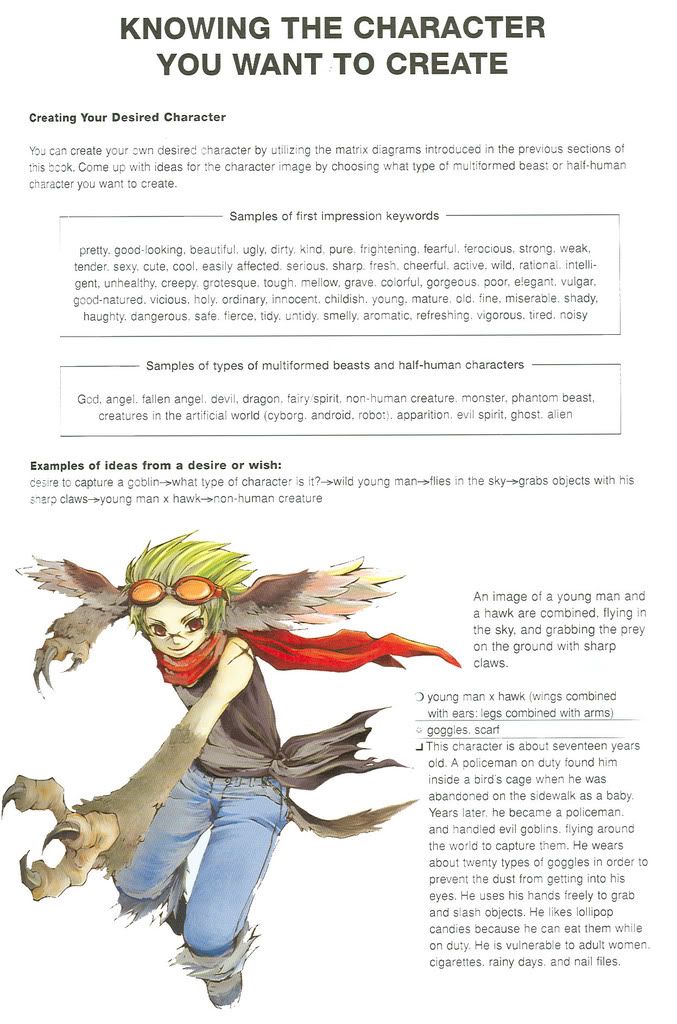
Addendum - A Couple Examples
Here's an example that has a fully fleshed out description of what came out of each matrix section.
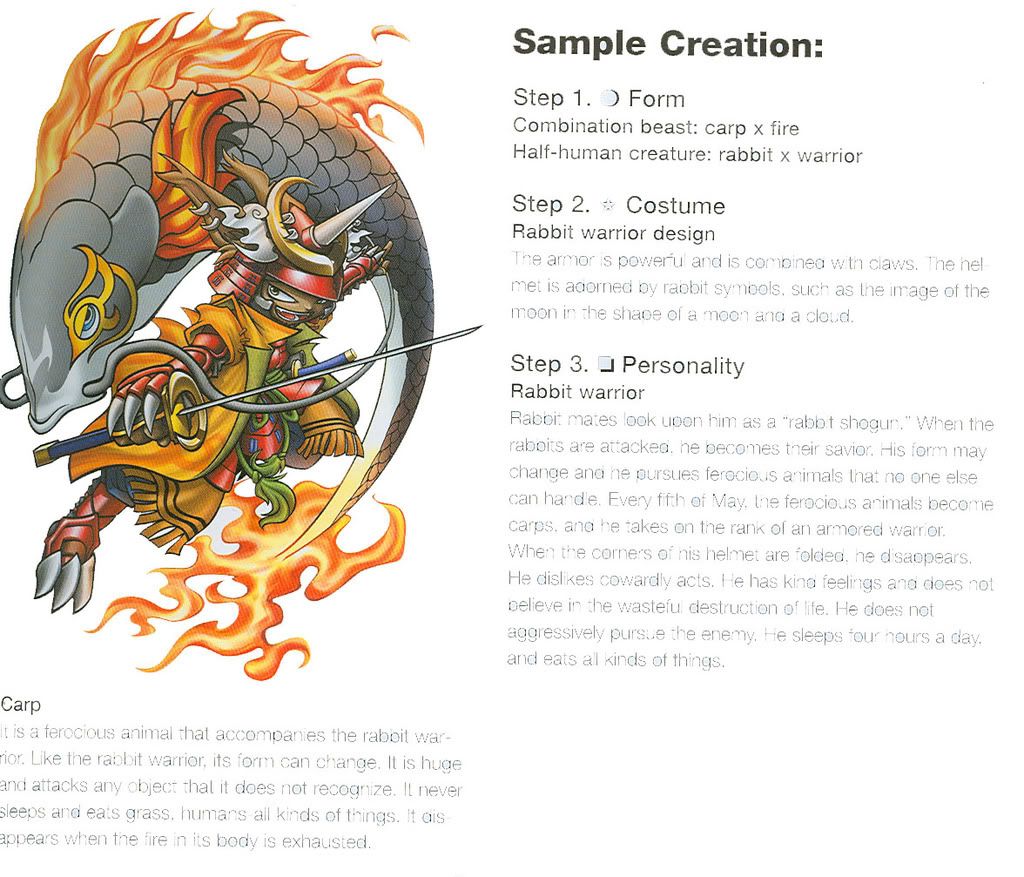
And this other one is just my personal favorite twist on rethinking stereotypes.
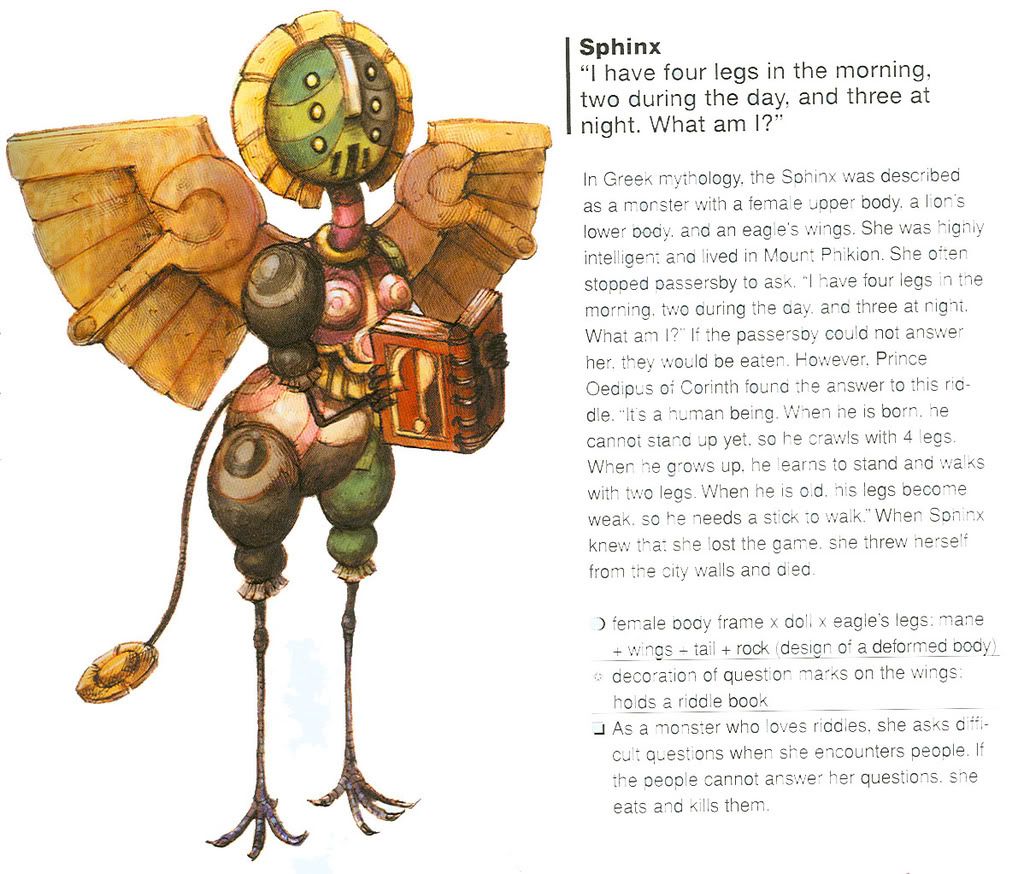
((Depending on my mood and level of boredom, I may be posting a few Navis I've created from inspiration of this method here.))

